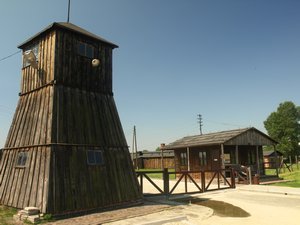Advertisement
Published: August 10th 2009

 Camp Entrance
Camp Entrance
The front entrance to the concentration camp.One weekend, several of the students in our program made a trip to Majdanek Concentration Camp outside of Lublin. Majdanek was one of the very worst of the concentration and death camps set up by the Nazis during World War II. It stands on the outskirts of Lublin, which was meant to be one of the administrative centers of the Nazi regime after the war. This camp is strange in that it is near a major city, not in a more secluded part of Poland like Auschwitz. The camp was established in 1941, initially as a prisoner of war camp. Although the camp was intended to hold nearly 250,000 prisoners, a disease outbreak killed off all of the initial forced labor, and as a consequence, the camp remained partially uncompleted throughout they war. Nevertheless, it held about 50,000 prisoners, most of which ended up being Jews. A morbid, yet unique characteristic of the Majdanek camp is that it used all of the major methods for killing prisoners that the Nazis would employ throughout the war. Early on, prisoners were gassed with carbon monoxide, which was a very slow process. Later, xyclon B gas was used which caused very quick, violent deaths.

 Majdanek Monument
Majdanek Monument
The major monument at the camp dedicated to the 80 thousand people who died as prisoners there.In November of 1943, nearly 19,000 prisoners were shot in a single day and then thrown into large trenches that had been dug. By the end of World War II, around 80,000 prisoners had been killed at the Majdanek concentration camp. Visiting the camp was a very moving experience, much like when I visited Auschwitz. Majdanek is perhaps more impactful because there is more left of the camp. One entire barrack is filled with crates of shoes, left from prisoners who were killed. Majdanek was the site of a large sorting facility which managed the personal belongings of all many prisoners of the camp and other camps as well. Also at Majdanek is an example of one of the crematoriums that worked to dispose of the bodies of prisoners. After the war, it was discovered that the ashes of prisoners was scattered over the entire grounds of the camp. These ashes were collected after the war and placed in a large mausoleum which is located at one end of the camp. Like visiting Auschwitz, my visit to Majdanek was quite powerful. While I found it very interesting, I can't say that I would like to ever return.
Advertisement
Tot: 0.185s; Tpl: 0.012s; cc: 13; qc: 97; dbt: 0.0911s; 1; m:domysql w:travelblog (10.17.0.13); sld: 1;
; mem: 1.3mb

 Camp Entrance
Camp Entrance
 Majdanek Monument
Majdanek Monument





























Sarah
non-member comment
Thanks so much for these pictures they are truly amazing and you really helped me with a project. This really helps show what it must have been like.